The edge of a flower bed is like the hem of a well-tailored jacket. It doesn’t just keep things tidy – it makes the whole thing pop. You can have the most jaw-dropping blooms on Earth, but if the edges are messy or blah? Meh. It’s like a beautiful picture in a cheap frame. Doesn’t work. Let’s fix that.
Alright, let’s get real. Garden edging isn’t exactly the sexiest topic at a dinner party, right? But it should be. It’s where your wild flower dreams meet order. It’s the line between chaos and charm. The magic’s in the margins.
We’re gonna dig (yep, pun 100% intended) into ten of the absolute best flower bed edging ideas. Some are bold. Some are subtle. Some are so charming you might wanna marry them. All of ’em will make your garden a proper showstopper.
1. Natural Stone Edging – Rugged Beauty That Just Works
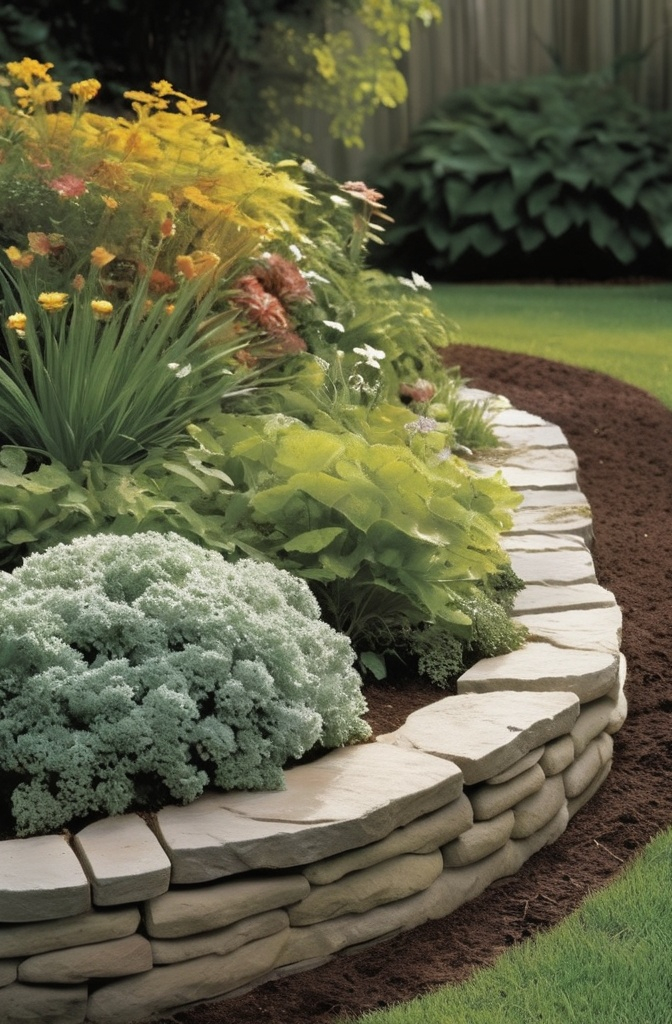
There’s something about natural stone that just screams I’ve got my life together. Even when it hasn’t. Stone’s rugged, timeless, and pretty much goes with everything. It whispers luxury without being a diva.
The key with stone edging is irregularity. Let it be a bit crooked. Don’t force it into a pattern. That rough-around-the-edges look? Pure gold. It makes your flowers look like they’ve grown there forever, like they belong. You can use flagstones, fieldstone, river rocks — even the odd boulder if you’re feelin’ dramatic.
Downside? It ain’t cheap. But if you can swing it, stone edging is the garden equivalent of having a leather-bound library and a Scottish accent. Elite vibes.
2. Brick Edging – Neat, Tidy, and Kinda British
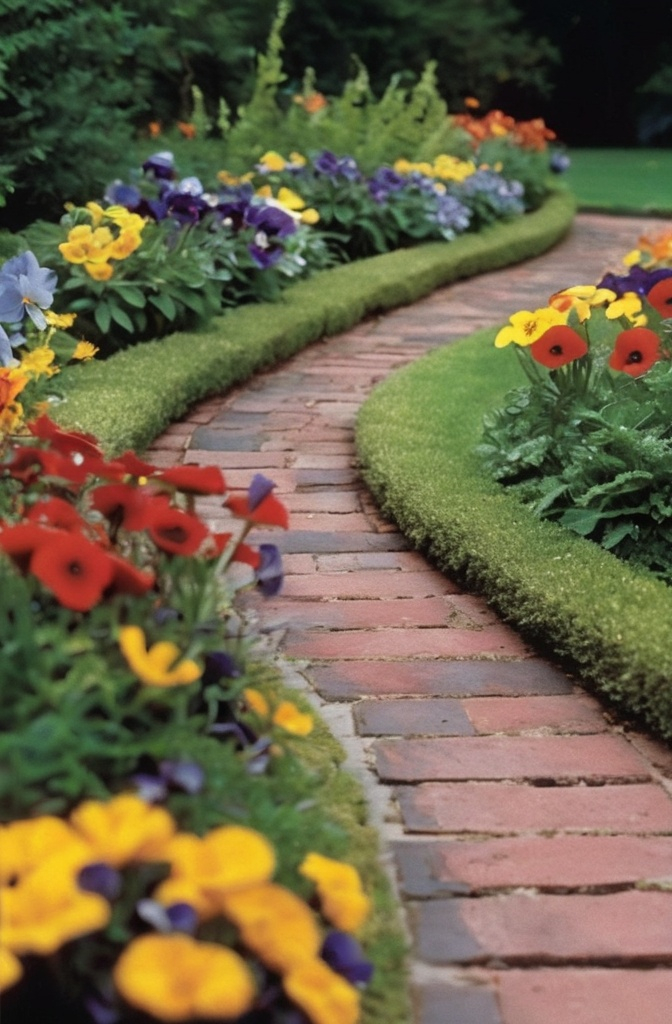
If your garden was a person, brick edging would be that mate who always shows up on time and somehow never gets muddy. Classic. Polished. A bit posh, even.
Laid flat or tilted at a jaunty angle, bricks give off serious structure. They keep mulch in line and stop grass from misbehaving. And they age so well. That soft mossy fade after a few years? Chef’s kiss.
Red bricks are the obvious choice, but don’t sleep on dark greys or reclaimed ones with stories in their chips and scars. Those imperfections make ‘em cooler. Honest.
And hey, you can DIY this with a shovel and a weekend. Maybe a few swear words. Worth it.
3. Metal Edging – Sleek, Sharp, Surprisingly Sexy
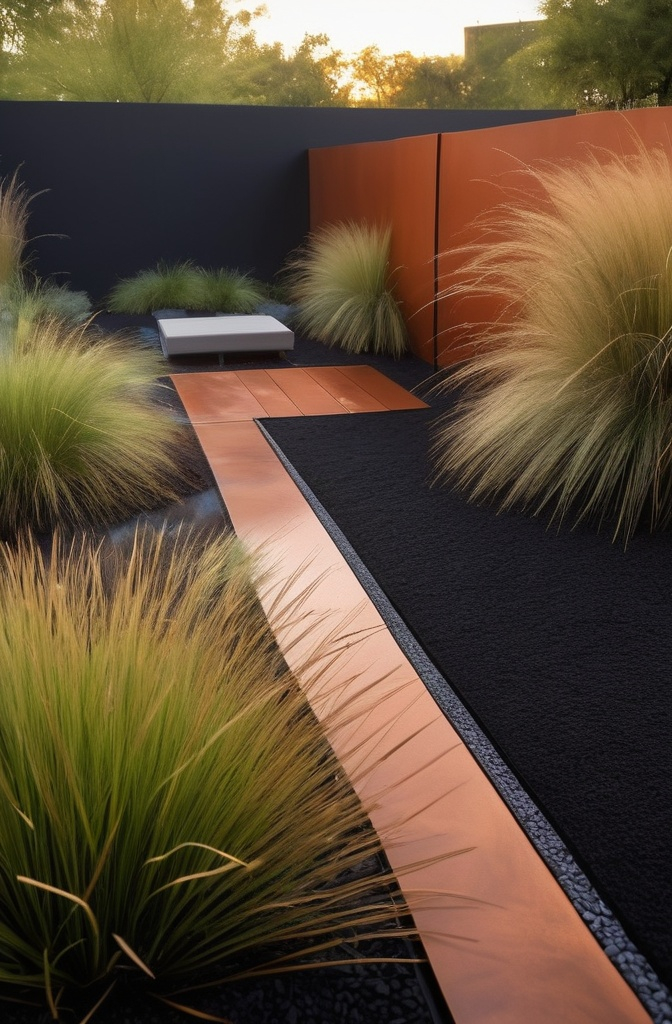
Metal in the garden? Oh yes. It’s a vibe.
Think thin, clean lines slicing through a sea of petals. Steel, aluminum, or even corten steel if you’re feelin’ fancy — all of it screams contemporary cool. It’s like putting eyeliner on your flower beds.
The wild part? Metal edging kinda disappears when done right. It holds back soil like a champ but doesn’t scream for attention. Until someone notices and goes, “Wait, how is that so clean??” Boom.
Corten steel, that rusty orange-brown metal, is having a real moment. It weathers beautifully. Like your favorite leather boots but sharper.
Just don’t trip on it. It’s got edges like your ex.
4. Wood Edging – Soft, Natural, Low-Key Lovely
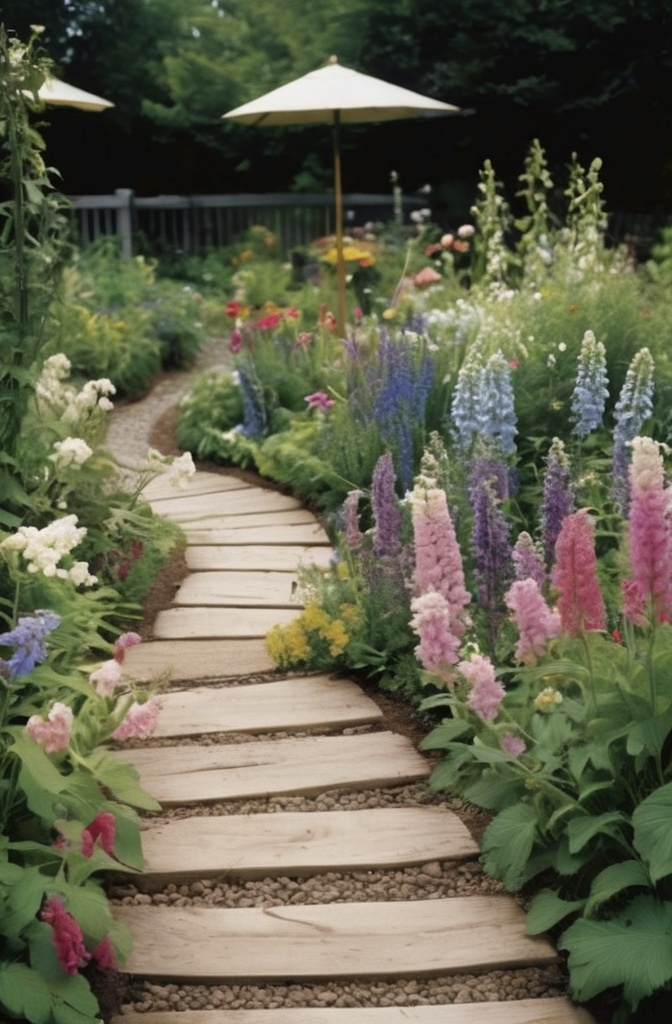
Wood. It’s cozy. Familiar. It’s the cardigan of garden edging.
There’s a million ways to do this — cedar planks, short log rounds, railroad ties (if you’re feelin’ rugged). It’s especially great if you’re going for that woodland, barefoot-in-the-grass vibe. Soft on the eyes, softer on the toes.
Thing is, wood doesn’t last forever. Moisture, bugs, time — they all want a piece. But honestly? That decay can be part of the charm. It becomes part of the landscape. Like your grandma’s old fence that’s still hangin’ in there.
Pro tip: don’t use treated wood if your flowers are edible. Chemicals, y’know. Nature doesn’t like those.
5. Concrete Edging – Solid, Serious, Surprisingly Stylish
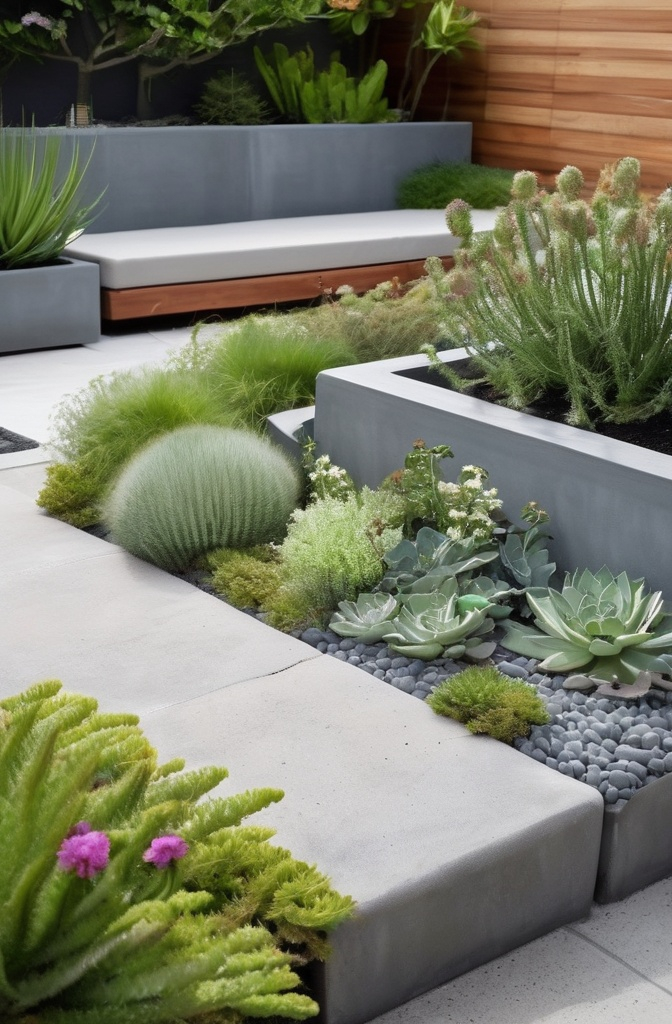
Concrete gets a bad rap. People think sidewalks, not flower beds. But hear me out — done right, concrete edging can be clean, curvy, and surprisingly elegant.
You can pour it into molds for that classic rounded edge, or go full brutalist and cast chunky blocks. Either way, it stays put. Forever. This stuff laughs in the face of weather.
Also? You can stain or paint it. Want a pop of teal around your daisies? Concrete’s got you.
It’s a commitment though. Like a tattoo. Don’t do it unless you’re sure. But when you are? It’s forever love.
6. Gabion Walls – Rock Cages That Rock (Literally)

Alright. These are weird. But weird in the best way.
Gabions are wire cages filled with rocks. Sounds a bit mad, yeah? But they look so cool. Industrial meets nature. Heavy metal meets peonies. It shouldn’t work — but it absolutely does.
They’re bold. You’re not hiding anything with a gabion. It’s like yelling, “LOOK AT ME” in stone language. And people will.
They also make great mini retaining walls. So if your garden’s on a slope, two birds, one rock cage.
Fair warning: they’re heavy. And fiddly to build. But once they’re in? Solid as a mountain.
7. Bottle Edging – Quirky, Cute, Basically Free
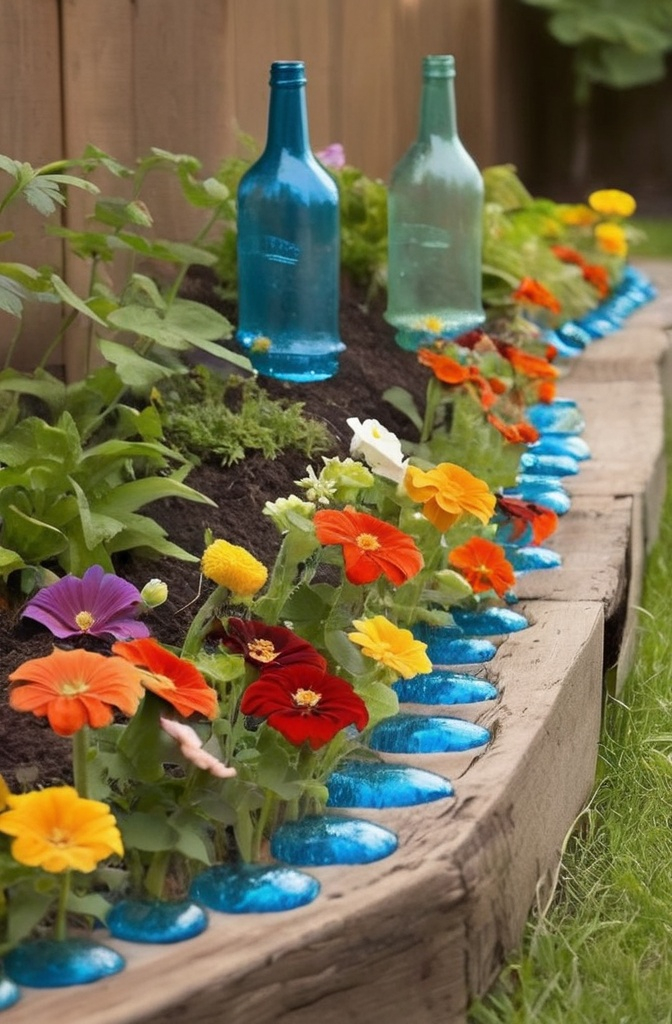
Got a recycling bin full of glass bottles? Congratulations. You’re halfway to a unique garden edge.
Dig a shallow trench. Flip those bottles upside down. Line ‘em up. Voilà — instant charm.
Clear bottles catch the sunlight. Brown ones fade into the earth. Greens and blues? Pure magic. It’s like a drunk fairy designed your garden and nailed it.
Yes, it’s whimsical. No, it won’t win any awards for durability. But for small beds or corners you wanna show off? It slaps.
Oh, and it’s eco-friendly too. Which feels nice.
8. Terracotta Tiles – Mediterranean Feels Without The Plane Ticket
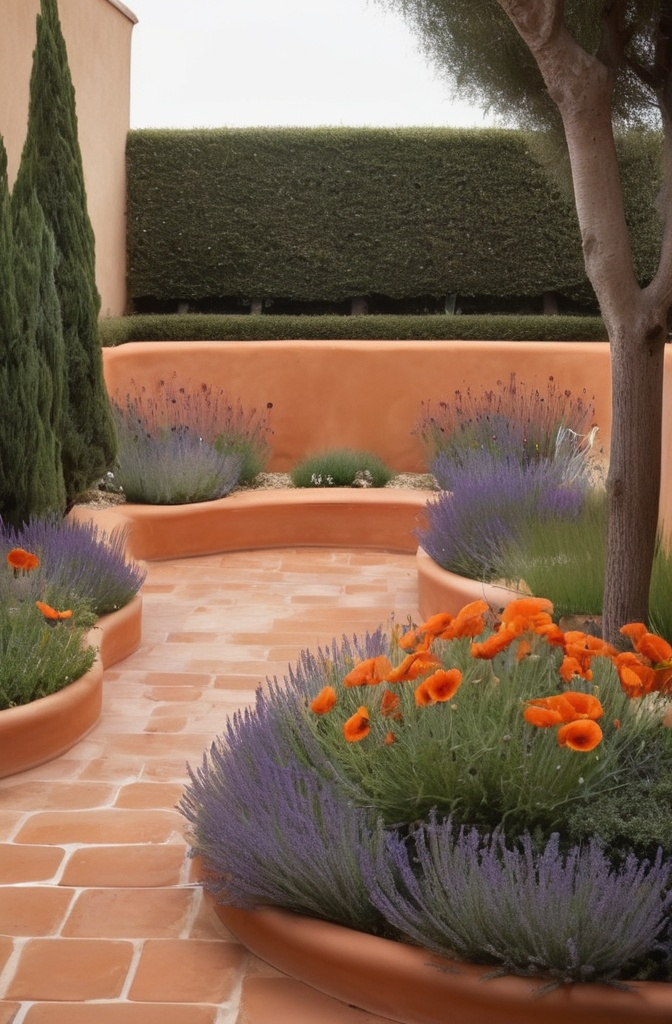
Want a garden edge that whispers “Tuscany” even if you live in Stoke-on-Trent? Terracotta tiles are your pal.
Lay them flat, stand them on edge, or angle them like tiny rooftops. They add that warm, sunbaked vibe that makes your geraniums look European.
Plus, they’re kinda unexpected. You don’t see this edging everywhere, and that’s part of the charm. It’s like your garden has secrets. And terracotta is keeping ‘em.
Not the best for frosty places, though. They can crack if winter bites too hard. But honestly? Worth the risk.
9. Living Edges – Plants That Play By the Rules

Here’s a wild one: use plants to edge your plants.
Low-growing herbs like thyme, chamomile, or dwarf lavender make soft, fragrant borders that buzz with bees and charm. They spill over the edges just enough to look effortless. Like they didn’t even try.
It’s a bit high-maintenance. You gotta trim ‘em. Keep them in line. Like rebellious teenagers in green form. But they pay you back in scent and softness and whimsy.
Perfect if you want your garden to feel alive everywhere — even the edges.
And bonus? If you’re barefoot, it’s basically a spa day.
10. Reclaimed Stuff – Junkyard Gold for Edgy Souls
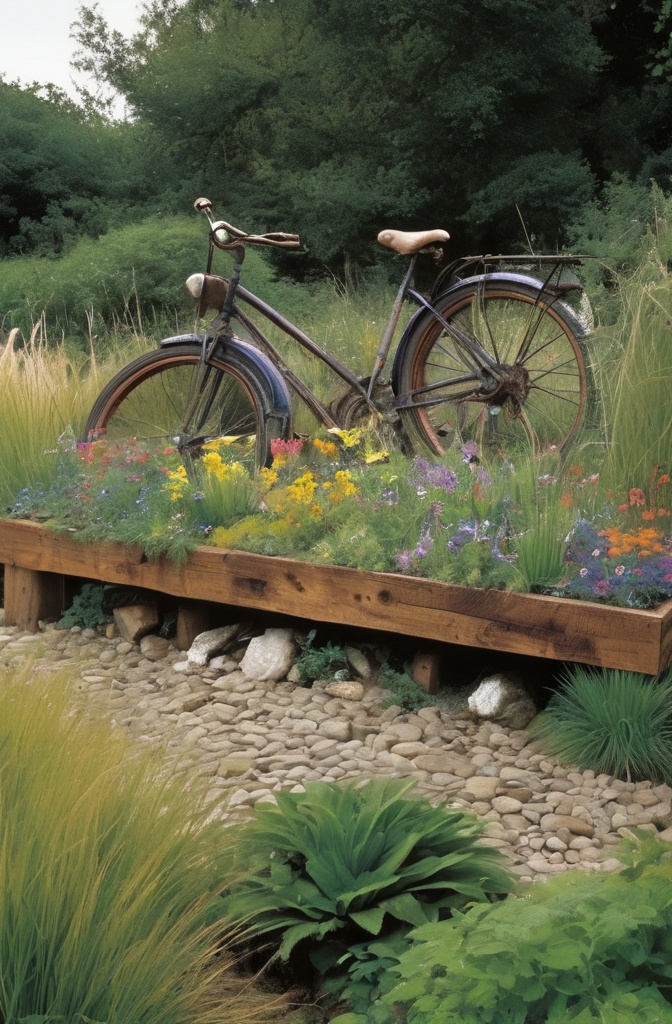
Old roof tiles. Bent forks. Rusty bed frames. Worn-out skateboards. If it holds a line, it can be garden edging.
Reclaimed edging is all about personality. It’s scrappy and soulful and tells a story. It says you’re clever. That you see beauty in weird places. That your garden’s got flavor.
It’s not for neat freaks. And definitely not for perfectionists. But if you love gardens that feel like old record shops or vintage bookshops? This is your jam.
Also? Cheap. Often free. You just gotta keep your eyes peeled.
Sometimes the best edge is the one that doesn’t match anything else.
11. Rope Edging – Nautical, Casual, and Cozy
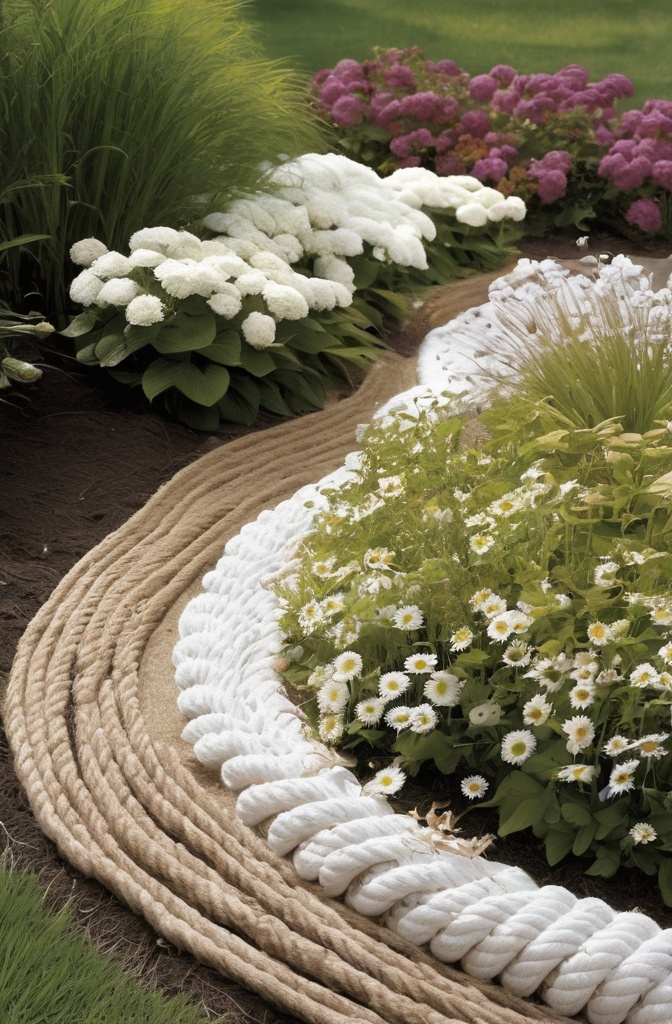
If you’re looking for something a bit quirky, rope edging might be your best bet. Think of it as the garden’s version of a laid-back beach vibe. You can get natural hemp or jute rope and wrap it around your flower bed in coils or spirals. It’s rustic and charming, plus it’s flexible in design — so if you want a curvy line or a more straight-edged look, it’s your call.
The downside? It won’t last forever. The rope will eventually wear out, especially if it’s exposed to the elements. But while it lasts, it’s one of the easiest ways to bring a little beach-house mood to your backyard.
12. Tree Branches – Organic Edging That Feels Like a Forest Walk
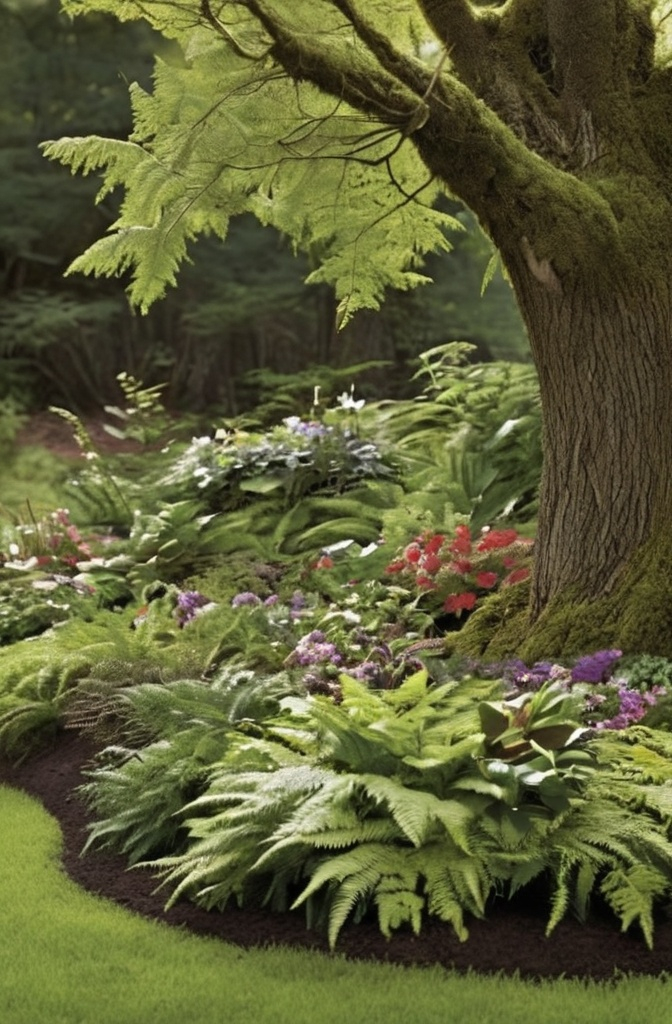
Want something that blends seamlessly with nature? Go for tree branches. Whether they’re fallen logs or pruned branches, placing them around your flower bed gives off that organic, woodland feel. It’s almost like the forest just decided to come to your garden.
Cut branches into short lengths, pile them together, or stand them up vertically. Either way, you’ve got a natural border that’s eco-friendly and unique. Plus, the texture of wood really contrasts nicely with the soft petals and leaves of your flowers.
13. Upcycled Pallet Wood – Industrial Edge With a Rustic Twist

Ever wondered what to do with all those wooden pallets lying around? Well, you can upcycle them into edgy flower bed borders! By cutting the pallets into sections, you can create a rustic, industrial-chic edge that’s full of character. It’s a nod to farmhouse style, with that perfect mix of worn-out wood and practical functionality.
Pallets are sturdy, so they keep soil in place and protect your flowers from encroaching grass. Plus, they add that “I’m too cool for perfect” aesthetic. A little bit of wear and tear gives it an inviting, lived-in vibe.
14. Glass Jar Edging – Repurpose and Reimagine

Here’s an idea that’ll make your neighbors do a double-take: glass jar edging. Instead of tossing old jars in the recycling bin, give them new life by turning them into a flower bed border. You can use mason jars, wine bottles, or any glass container that catches your eye. Stack them on top of each other, or bury them partway into the ground for a more polished look.
The beauty of this idea is in its creativity. You can paint the jars, leave them clear for a classic look, or even fill them with tiny stones or fairy lights for added magic. It’s quirky and eco-friendly — what’s not to love?
15. Sandstone Edging – Softly Weathered, Still Strong

Want an edging that screams sophistication without being overly formal? Sandstone might just be your perfect match. Its soft, warm hues provide a gentle contrast to vibrant flowers. Plus, it’s one of those materials that looks better as it weathers — the more the sun hits it, the more character it gets.
You can stack it in low, neat rows or place it in a more haphazard pattern. Either way, it brings a natural, earthy vibe to your garden that feels effortless and inviting.
16. Seashell Edging – Coastal Charm on Your Flower Bed
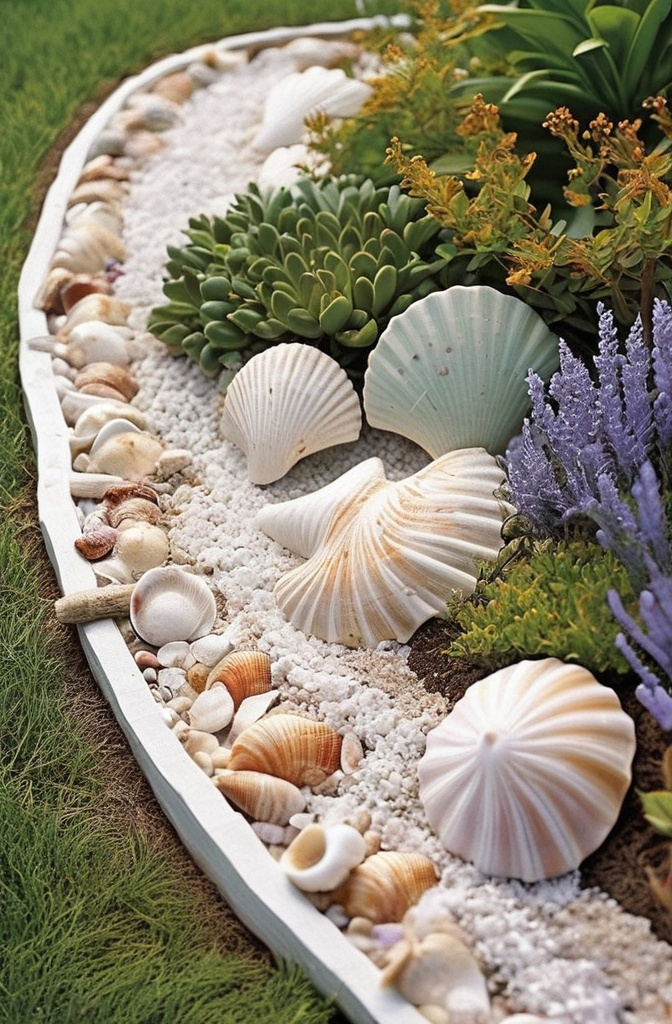
For those who love the beach, seashells are a fantastic and unexpected way to edge your flower beds. It’s like bringing the ocean to your backyard — minus the salty air and sand. You can line them along the edge in a thin, compact line, or create a thicker border by layering them.
Whether you collect them yourself or buy them in bulk, they add texture, charm, and a little bit of that coastal feel. Just be careful if you live in a very wet area; seashells can deteriorate over time when exposed to moisture.
17. Recycled Glass Bottles – Bright, Colorful, and Eco-Friendly
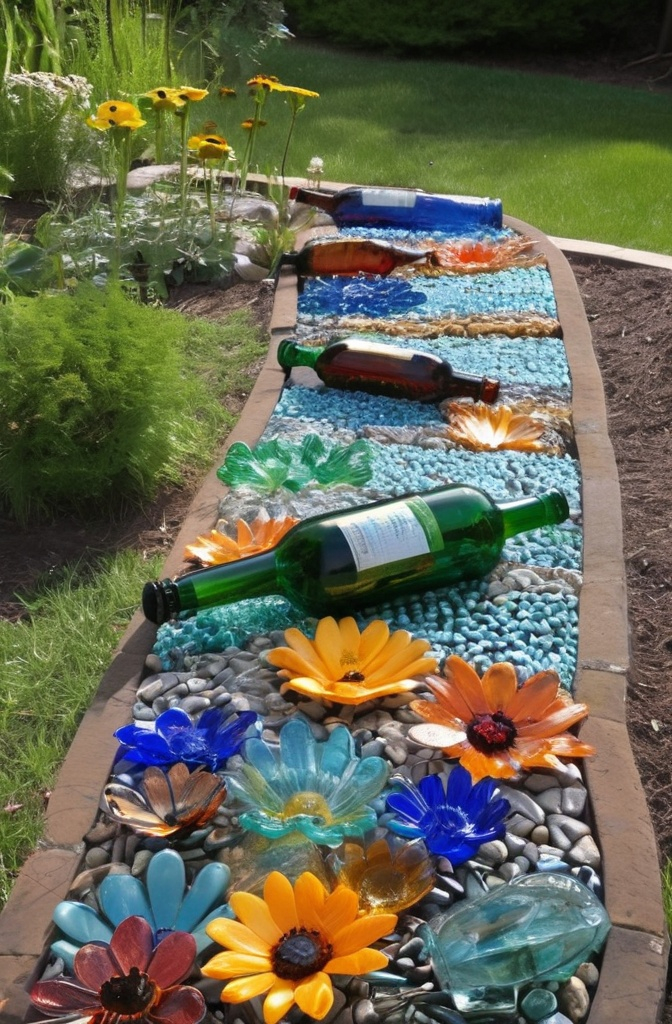
Have a stash of glass bottles from the last party? Put them to good use by creating a colorful and eco-friendly garden border! You can place them upside down to form a neat and stable edge, or arrange them vertically to make a unique, eye-catching feature.
The beauty of glass bottles is that they come in all sorts of colors, so you can create a beautiful rainbow effect as they catch the light. They’re quirky and cost next to nothing, especially if you’ve got a few bottles laying around from your recycling bin.
18. Concrete Planters as Edging – Functional Meets Stylish

Instead of the usual stone or brick edge, why not use concrete planters to mark the boundary of your flower bed? This is both practical and stylish. The concrete planters act as a sturdy barrier, but they also offer a place to add additional plants or small flowers to your flower bed.
You can choose minimalist square planters, or get creative with ornate designs. This edging technique can be particularly handy if you want to incorporate both edging and extra growing space in one go.
19. Recycled Tire Edging – Tough, Bold, and Green
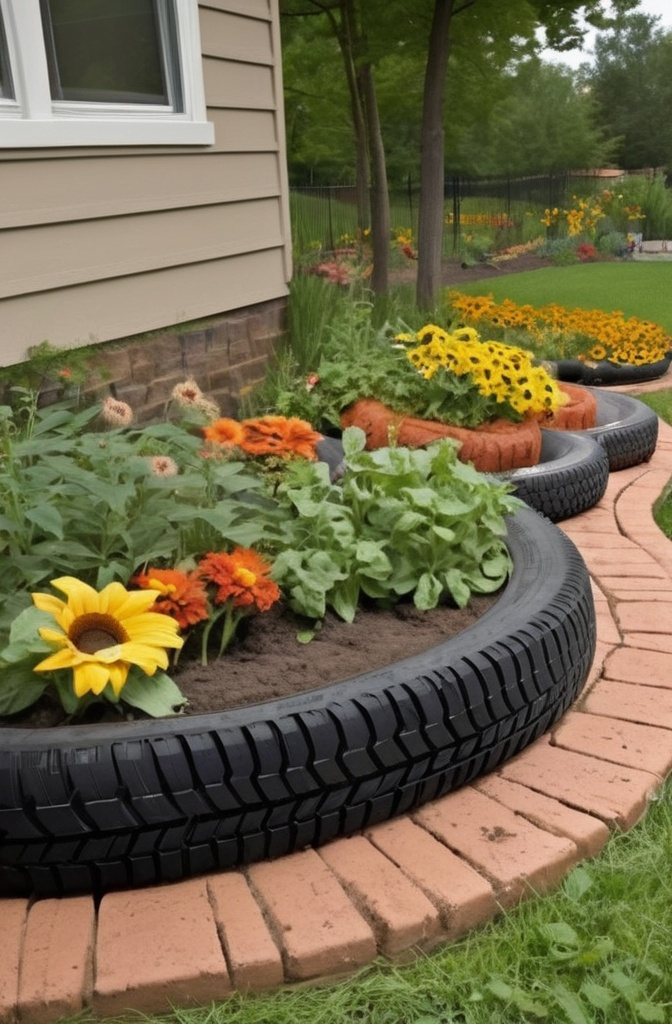
Old tires are often discarded, but if you’ve got a few around, you can easily repurpose them into a tough, bold flower bed border. Stack them in a circle for a simple round bed, or cut them into strips and arrange them like brickwork. If you have a more industrial garden, this could add that raw, edgy charm.
Tires are durable and will hold up through all weather, so they’re a practical choice for long-term edging. Plus, they keep the soil in check and can even double as extra planters if you want to get crafty.
20. Dried Bamboo Edging – Exotic, Minimal, and Stylish
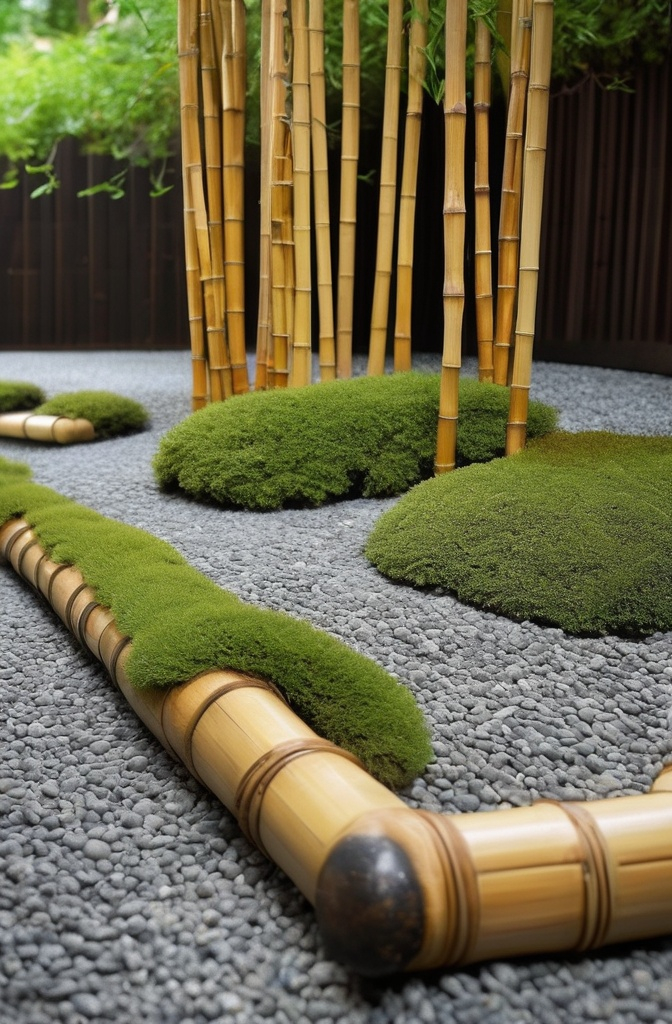
Bamboo is one of those materials that seems to always look fresh and natural. Dried bamboo poles can be turned into an elegant and slightly exotic garden border. Their tall, slender appearance creates a light, breezy edge that’s perfect for a minimalist or zen garden.
You can arrange the bamboo in a simple, straight line, or get creative with shapes. It’s an ideal option for those who want to add a touch of Asia-inspired tranquility to their outdoor space. Plus, bamboo naturally grows in clusters, so it fits in perfectly with your plant-filled flower beds.
Final Thoughts
Okay, so that’s ten. Ten wildly different, gloriously chaotic ways to edge a flower bed and make your garden the kinda place people take photos of. But here’s the truth — the best edging is the one that makes you grin when you look at it.
Maybe it’s a line of tidy bricks that makes you feel organized for once. Maybe it’s a row of bottles from parties you barely remember. Maybe it’s just a line of thyme that smells like a forest picnic when the sun hits it.
Don’t overthink it. Flowers don’t. They just bloom.
So grab your spade. Throw on some tunes. And give those beds the borders they deserve. Because honestly? The edge is where the magic starts.
Want help picking the right one for your climate or soil type?
FAQs
What is the best material for flower bed edging?
The best material depends on your style and garden needs, with options like stone, wood, and metal being top choices.
Can I make my own flower bed edging?
Yes, many of the ideas in the article, like using pallets, ropes, or glass bottles, are perfect for DIY projects.
How long does wood edging last?
Wood edging can last 5-10 years, depending on the type of wood and exposure to the elements.
Are recycled materials good for flower bed edging?
Absolutely! Recycled materials like bottles, tires, and pallet wood can create unique, eco-friendly edges.
Can I use seashells for flower bed edging in wet climates?
Seashells may deteriorate in very wet climates, so they’re better suited for drier areas.
How do I maintain metal edging?
Metal edging requires minimal maintenance, but occasional cleaning and checking for rust will keep it looking good.
Can bamboo edging withstand harsh weather?
Dried bamboo can withstand mild weather but may need protection in very cold or wet climates.
Is concrete edging expensive?
Concrete edging can be costly, especially if custom work is required, but it’s durable and long-lasting.
Are there any low-cost flower bed edging options?
Yes, options like rope, glass jars, and recycled bottles are affordable and easy to implement.
Can I mix different edging materials in my garden?
Yes, mixing materials like stone with wood or metal can create a dynamic and interesting garden edge.

Emma is a passionate home decor enthusiast and the voice behind Home Evoke. With a keen eye for design and a love for transforming spaces, she shares her expertise and creative ideas to help others create beautiful, functional homes. Through her blog, Emma inspires readers with practical tips, trend insights, and DIY projects that make home styling effortless and enjoyable.

